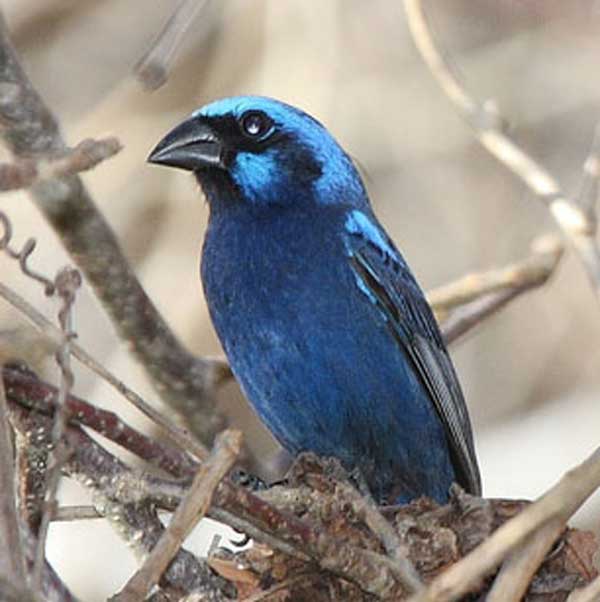
Cyanocompsa parellina (*)
Superregnum: Eukaryota
Regnum: Animalia
Subregnum: Eumetazoa
Cladus: Bilateria
Cladus: Nephrozoa
Superphylum: Deuterostomia
Phylum: Chordata
Subphylum: Vertebrata
Infraphylum: Gnathostomata
Megaclassis: Osteichthyes
Cladus: Sarcopterygii
Cladus: Rhipidistia
Cladus: Tetrapodomorpha
Cladus: Eotetrapodiformes
Cladus: Elpistostegalia
Superclassis: Tetrapoda
Cladus: Reptiliomorpha
Cladus: Amniota
Classis: Reptilia
Cladus: Eureptilia
Cladus: Romeriida
Subclassis: Diapsida
Cladus: Sauria
Infraclassis: Archosauromorpha
Cladus: Crurotarsi
Divisio: Archosauria
Cladus: Avemetatarsalia
Cladus: Ornithodira
Subtaxon: Dinosauromorpha
Cladus: Dinosauriformes
Cladus: Dracohors
Cladus: Dinosauria
Ordo: Saurischia
Cladus: Eusaurischia
Cladus: Theropoda
Cladus: Neotheropoda
Cladus: Averostra
Cladus: Tetanurae
Cladus: Avetheropoda
Cladus: Coelurosauria
Cladus: Tyrannoraptora
Cladus: Maniraptoromorpha
Cladus: Maniraptoriformes
Cladus: Maniraptora
Cladus: Pennaraptora
Cladus: Paraves
Cladus: Eumaniraptora
Cladus: Avialae
Infraclassis: Aves
Cladus: Euavialae
Cladus: Avebrevicauda
Cladus: Pygostylia
Cladus: Ornithothoraces
Cladus: Euornithes
Cladus: Ornithuromorpha
Cladus: Ornithurae
Cladus: Carinatae
Parvclassis: Neornithes
Cohors: Neognathae
Cladus: Neoaves
Cladus: Telluraves
Cladus: Australaves
Ordo: Passeriformes
Subordo: Passeri
Infraordo: Passerida
Superfamilia: Passeroidea
Familia: Cardinalidae
Genus: Cyanocompsa
Species: Cyanocompsa parellina
Subspecies: C. p. beneplacita - C. p. indigotica - C. p. lucida - C. p. parellina
Name
Cyanocompsa parellina (Bonaparte, 1850)
References
Conspectus generum avium 1 p.502
Vernacular names
English: Blue Bunting
The blue bunting (Cyanocompsa parellina) is a species of passerine in the family Cardinalidae, the cardinals or cardinal grosbeaks. It is found in Belize, El Salvador, Guatemala, Honduras, Mexico, and Nicaragua.[2]
Taxonomy and systematics
French naturalist Charles Lucien Bonaparte described the blue bunting in 1850 as Passerina parellina, and then Cyanoloxia parellina. German ornithologist Jean Cabanis defined the genus Cyanocompsa in 1861, giving it its current binomial name.
The blue bunting is the only member of its genus. It has four subspecies, the nominate Cyanocompsa parellina parellina, C. p. beneplacita, C. p. indigotica, and C. p. lucida.[2] The last is sometimes included in C. p. beneplacita.[3]
Description
The nominate subspecies of blue bunting is 13 to 14 cm (5.1 to 5.5 in) long. Males weigh 11 to 24 g (0.39 to 0.85 oz) and females 9.8 to 21 g (0.35 to 0.74 oz). The nominate male is various shades of blue, sky blue on the forehead and cheek, blackish blue on the upperparts, ultramarine on the rump, and the underparts from chin to belly deep blue. The adult and immature females are overall dull browish, with a reddish tinge to the belly. The immature male is overall gray-blue with a browish wash on the belly.[3]
Compared to the nominate, the C. p. beneplacita male is a duller blue and the female paler and with less of a reddish tinge on the belly. The male C. p. lucida's blue is between those of the nominate and C. p. beneplacita and the sky blue covers more of its head. The female is similar to that of beneplacita. The male C. p. indigotica is dull indigo on the darker areas and cerulean on the lighter ones; the female is lighter brown than the nominate.[3]
Distribution and habitat
The nominate subspecies of blue bunting is the most widespread. It occurs from Veracruz in eastern Mexico south and east through Belize, Guatemala, Honduras, and El Salvador into northwestern Nicaragua. C. p. beneplacita is mostly confined to Nuevo León in northeastern Mexico, though it occasionally wanders into Texas and Louisiana. C. p. lucida is found in northeastern and eastern Mexico. C. p. indigotica ranges in western Mexico from Sinaloa south to Oaxaca and Chiapas.[3][2]
The blue bunting inhabits dense vegetation such as scrubby areas, thickets, and the undergrowth and edges of tall forest. In elevation it ranges up to 1,800 m (5,900 ft) in Mexico and to 900 m (3,000 ft) in Guatemala.[3]
Behavior
Feeding
The blue bunting forages singly or in pairs through low vegetation. Its diet has not been described.[3]
Breeding
Little information published about the blue bunting's breeding phenology. Nests have been described; they were cups made of rootlets and other fine plant material and placed in bushes. Clutches were of two and three eggs.[3]
Vocalization
The blue bunting's song is "a sweet, rather sad warble" [1]. Its call is a metallic note [2].[3]
Status
The IUCN has assessed the blue bunting as being of Least Concern.[1] It is fairly common and "[s]eems able to accept moderate modification of habitat."[3]
References
BirdLife International (2020). "Blue Bunting Cyanocompsa parellina". IUCN Red List of Threatened Species. 2020. Retrieved 17 May 2021.
Gill, F.; Donsker, D.; Rasmussen, P. (January 2021). "IOC World Bird List (v 11.1)". Retrieved January 14, 2021.
Brewer, D. (2020). Blue Bunting (Cyanocompsa parellina), version 1.0. In Birds of the World (J. del Hoyo, A. Elliott, J. Sargatal, D. A. Christie, and E. de Juana, Editors). Cornell Lab of Ornithology, Ithaca, NY, USA. https://doi.org/10.2173/bow.blubun.01 retrieved May 17, 2021
Retrieved from "http://en.wikipedia.org/"
All text is available under the terms of the GNU Free Documentation License

